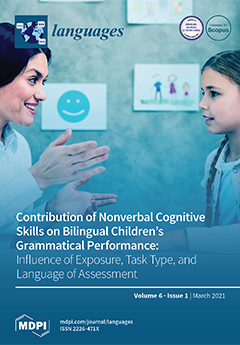Studies have shown that “framing bias,” a phenomenon in which two different presentations of the same decision-making problem provoke different answers, is reduced in a foreign language (the Foreign Language effect, FLe). Three explanations have emerged to account for the difference. First, the
[...] Read more.
Studies have shown that “framing bias,” a phenomenon in which two different presentations of the same decision-making problem provoke different answers, is reduced in a foreign language (the Foreign Language effect, FLe). Three explanations have emerged to account for the difference. First, the
cognitive enhancement hypothesis states that lower proficiency in the FL leads to more deliberate processing, reducing the framing bias. Second, contradicting the previous, the
cognitive overload hypothesis, states that the cognitive load actually induces speakers to make less rational decisions in the FL. Finally, the
reduced emotionality hypothesis suggests that speakers have less of an emotional connection to a foreign language (FL), causing an increase in rational language processing. Previous FLe research has involved both FL and non-FL speakers such as highly proficient acculturated bilinguals. Our study extends this research program to a population of heritage speakers of Spanish (HS speakers), whose second language (English) is dominant and who have comparable emotional resonances in both of their languages. We compare emotion-neutral and emotion-laden tasks: if reduced emotionality causes the FLe, it should only be present in emotion-laden tasks, but if it is caused by cognitive load, it should be present across tasks. Ninety-eight HS speakers, with varying degrees of proficiency in Spanish, exhibited cognitive biases across a battery of tasks: framing bias appeared in both cognitive-emotional and purely cognitive tasks, consistent with previous studies. Language of presentation (and proficiency) did not have a significant effect on responses in cognitive-emotional tasks, but did have an effect on the purely-cognitive Disjunction fallacy task: HS speakers did better in their second,
more proficient language, a result consistent with neither the reduced emotionality hypothesis nor the cognitive enhancement hypothesis. Moreover,
higher proficiency in Spanish significantly improved the rate of
correct responses, indicating that our results are more consistent with the cognitive overload hypothesis.
Full article





